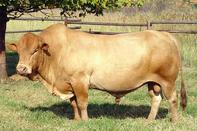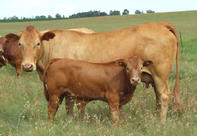The Tuli is a “fertile, profitable, range cattle”, as per the Tuli Cattle Breeders Society of South Africa logo.

African cattle are classified into those with humps and those without humps. Those with humps are again divided into two groups, with the Zebu having their humps back on the thorax and the Sanga having theirs more forward on the neck.
The Tuli forms part of the Sanga group, which according to DNA tests have existed for over 2000 years. These early animals were brought into Southern Africa by migrating tribes and in time became abundant in the whole area south of the Zambezi.
Len Harvey, a South African born agricultural adviser, noticed that among the Tswana type cattle, in the South Western corner of Zimbabwe, there was a particular yellow type of Sanga, consistently in good condition and seemingly better adapted to the environment.
In the late 1940s, he convinced the government to begin with a breeding program to improve the indigenous cattle through a process of selection, instead of crossbreeding with European breeds that probably would never survive the very hostile environment. The Tuli breed was registered as an indigenous Rhodesian breed in 1955.
The breed almost became extinct during the Zimbabwean War of Liberation. One night in 1979, all the workers at the Tuli Breeding Station were abducted. Within 48 hours a rescue mission was launched, during which all the Tuli’s were moved to the Matopos Research Station outside Bulawayo.
Production in South Africa
In 1976, the Bornmann family along with a family relation by marriage, Dr Fanie Kellerman, became the first to import Tuli cattle into South Africa.
As reported by the Tuli Cattle Breeders Society of South Africa, Dr Kellerman, who was a veterinarian, became impressed with the Tuli breed, after becoming aware of them when he worked in Zimbabwe. The family imported thirty pregnant females and three bulls from the Tuli Breeding Station in Zimbabwe to their farm in South Africa.
The breed, over time, grew in favour, resulting in the formation of the Tuli Cattle Breeders Society in 1995.
Attributes

This pure indigenous breed exhibits some outstanding qualities, that are important to extensive beef farmers: It has a medium frame, high fertility, is mostly polled, trouble-free calving, longevity with hardiness and adaptability, bred into it through a process of natural selection, over a period of at least two thousand years, resulting in a natural resistance against internal and external parasites.
In recent times, attributes of economic value have been the aim of scientific selection, resulting in the modern Tuli. Great care has always been taken not to compromise the natural hardiness and adaptability of the breed. Its colour is solid and ranges from white through shades of red, brown, dagha and yellow. The average weight for mature bulls ranges between 750 to 850 kg, while that of a mature cows ranges between 400 to 500 km.
Tuli cows have great maternal qualities, such as good fertility, milk production and low calf mortality, whereas the bulls grow well and have a good feed conversion ratio and carcass quality.
Production Regions
The Tuli breed is produced throughout South Africa thanks to its adaptability, hardiness and ability to turn even the worst graze into good quality meat.
The breed can be found flourishing in sandy, semi-desert areas in Namibia, Botswana and the Northern Cape; in hot heartwater bushveld areas such as Zimbabwe, Limpopo and the Lowveld of Mpumalanga; also in the high rainfall, sour veld, high altitude of Mpumalanga; in KwaZulu-Natal where red water and gall sickness is rife; in the Drakensberg Mountains where snow falls regularly; on the extensive savannah grassland of the Free State; in the arid Karoo; and in the cold misty mountains as well as coastal bush of the Eastern Cape.
Outside of Africa, the Tuli cattle are also produced in Australia, Argentina, Canada, the United States and North America.
Use
The unique genetic makeup of the Tuli makes it particularly successful in crossbreeding programs, resulting in good hybrid vigour and a large percentage of polled calves. Tuli steers and Tuli-cross calves also finish faster off the veld than many other breeds.
Meat Quality
According to test results by the Texas A&M University, the Tuli has the best rib eye to carcass ratio of any breed in the world. The breed’s hardiness makes it possible to “fatten them up” on the land, so their meat can truly be sold as “grass fed”.
For bulk or Tuli Beef export enquiries please use the enquiry link below.